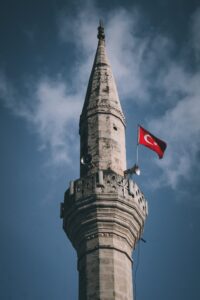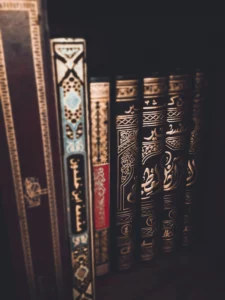Ummatics Colloquium: Media Forming and Undermining Ummatic Sentiments
Summary
Our October 2023 colloquium featured Dr. Salman al-Azami, Dr. Mohamad H. Elmasry, and Dr. Michael Munnik, each of whom focused on various issues related to the topic of media representation. Dr. al-Azami focused on the media’s Islamophobic portrayal of common Muslim language and the imperative for Muslims to reclaim their meaning, while the second panelist, Dr. Mohamad H. El–masry, highlighted data-driven insights revealing negative Muslim representation in news media. Dr. Michael Munnik’s research on journalistic style guides and the positive changes in terminology use were also discussed, with subsequent dialogue focusing on strategies for fostering unified Muslim sentiment.
Dr. al-Azami began by discussing his upcoming book, Media Language on Islam and Muslims: Terminologies and Their Effects, with particular emphasis on the way the
media’s responses to phrases like jihad, Sharia, and Allahu Akbar are Islamophobic. His argument is that the media has successfully manufactured negative associa–
tions with each of these terms in a way that has inured the public to the pernicious consequences of their expression. Because of this, a term like Allahu Akbar which is uttered daily by Muslims can become a byword for terroristic behavior and be a sufficient marker of suspicion against Muslims. Al-Azami argues that a pervasive culture of fear exists among many Muslims in the West because of the subtle policing of their language. Rather than let–
ting the media dictate what Muslim language means, he insists we must reclaim our own terms and normalize our understandings against those of the media. This, however, cannot happen without direct involvement in and with the media. It is therefore imperative for Muslims to actively participate in shaping the media, and to lead media initiatives instead of merely responding to preexisting narratives in the media.
Following Dr. al-Azami, Dr. Elmasry shared his own reflections on the representation of Muslims in the news media. He began by reflecting on a recent data study that exam–
ined 850,000 articles published in 17 American newspapers over a 20 year period that compared Muslims with Hindus, Jews, and Catholic. What the study found was that Muslims were more negatively covered than any other religious group. Elmasry notes that the negative tone about Muslims and Islam held over the years and was not affected when events were controlled for. This shows the depth of the insidiousness of media discourse
about Muslims and Islam and the implications for news consumers who only hear about Islam and Muslims in a negative light. Unfortunately, because non-Muslim victims are humanized in a way Muslims are not, the public is likely to normalize a dehumanized perception of Muslims. Elmasry notes the consequences of this extend beyond mere Islamophobia, as it also has to do with Muslim identity. Following these reflections, Elmasry touched on Muslim-majority representations of Islam and Muslims. Although there is not as much research in this area, the available data shows there is strong anti-Muslim sentiment in Egyptian, Emirati, and other media discourse. What this shows is that Muslims are marginalized even in Muslim-majority contexts, and this cultivates quietism and fear over time among the public. In conclusion, El–masry echoed Dr. al-Azami’s point about the need for Muslims to have more control over media production as a strategy for countering prevailing representations.
The final respondent, Dr. Michael Munnik, began by speaking about his own experience as a former journalist and how it spoke to much of what the previous two respondents had to say. Munnik emphasized the importance of the relationship between journalists and their sources and how narratives about Muslims are framed and constructed at the intersection of that relationship. In a recent paper he published, Munnik shows how problematic and not well-understood language like “fatwa” seeps into journalistic discourse and becomes difficult to correct because of its spread as well as the reliance of the media on previous discursive encounters, precedents, and production. Munnik says journalists ultimately make choices about what language to use, and what they choose to highlight shapes the media industry and its representation of Islam and Muslims. While journalists like to present themselves as neutral purveyors of objective information, the reality is that journalists are involved in a process of narrative construction and selection which cannot be seen as an idle practice. Munnik says it is important to identify the traces within news coverage of decision making about what language to use or avoid when it comes to reporting on Islam and Muslims, and what journalists do when they are confronted with a choice.
Responses/Q&A
Following the remarks made by the three presenters, the moderator, Dr. Usaama al-Azami, raised a question about the challenge of getting caught up in the distraction of media discourse, and what can we feasibly do to create an ummatic alternative. He proposed two points of reflection, the first about methodological nationalism, and the second about methodological secularism. The first assumes that nationalism as a framework is normal, while the second assumes that secularism as a framework is normal. Both of these frameworks, he suggested, need to be systemically questioned and problematized in the endeavor to challenge the prevailing media structures and narratives that drive negative attitudes about Islam and Muslims.
In response, Dr. Salman al-Azami agreed and emphasized the importance of community engagement. The mantle, he says, has to be taken up the Umma collectively rather
than particular nations. Nation-states, he says, are inherently dividing and therefore limiting. A proactive approach requires thinking that transcends those divisions
and limitations. In addition, we need to reflect on what is and isn’t possible or realistic in the production of counter narratives and alternative framings that are natural, non-imposed, and truly representative. Finally, he says, academic engagement with the community and intersectionality are both imperative in proactive approaches to the media.
than particular nations. Nation-states, he says, are inherently dividing and therefore limiting. A proactive approach requires thinking that transcends those divisions
and limitations. In addition, we need to reflect on what is and isn’t possible or realistic in the production of counter narratives and alternative framings that are natural, non-imposed, and truly representative. Finally, he says, academic engagement with the community and intersectionality are both imperative in proactive approaches to the media.
Dr. Mohamad Elmasry added to Dr. al-Azami’s comments by emphasizing the centrality and importance of narrative to identity construction and development. He asked what the implications are of Muslims not producing their own narratives, and said one consequence is that it constantly puts Muslims on the defensive. If Muslims were the ones “with the microphones,” the entire narrative would change and they would no longer be on the defensive. This is why Muslims need to take greater ownership over narrative construction.
In response to the question about whether we need to have a definition of Islamophobia, Dr. al-Azami endorsed a definition of Islamophobia that highlights it as a type of
racism that targets expressions of Muslimness and perceived Muslimness, but also said that having various definitions is acceptable. Dr. Munnik added to this response by noting that his own research has found that journalistic style guides do not rely on a specific or robust definition of Islamophobia. Rather, it is left to “discursive guides” to determine how the term should be used.
Another question raised by the audience was about the topics, areas, and methods that Muslim academics should engage in order to arrive at a future where the Umma no
longer has to worry about slander, demonization, and regulations intended to isolate them from power centers that include but are not limited to the media. Dr. Elmasry addressed this by saying that the Umma is currently in a state where there are a lot of internal efforts intended to undermine Muslim development and empowerment, and this is perhaps the greatest impediment to Muslim progress. But he also noted that Muslims need to start
thinking about careers in media and academia that will help usher a new generation that is primed to think in more serious ways about questions like this one and propose ways forward. Dr. al-Azami echoed these claims and emphasized the importance of thinking about careers that serve the Umma in the ways it needs. Dr. Munnik added to this by noting that while he agrees, it is a difficult time for young Muslims to choose careers in the humanities and social sciences given the broad challenges faced by these fields.
Another question raised was about the the roles of Muslim majority governments and private entities in correcting media perceptions, and whether the solution to media misrepresentations should come from one more than the other. In response, Dr. al-Azami noted that he does not believe governments are the solution to media misrepresentation. Rather, community-based efforts are paramount.
The colloquium ended with a discussion on self-censorship and the ways to navigate it. Dr. Elmasry said that in his own work, he has had to be strategic and self-censor; this is both unavoidable and to be expected anywhere and everywhere to varying degrees. He says that rather than focusing on the few things we might not be able to fully engage in, it is better to spend time on those issues we are able to fully and productively explore.



